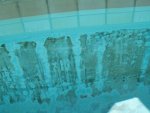I have had it with this black algae. :x I have kept my ph @ 7.2 with TC up to 48 to 65, by CYA is 100 and a TA of 80 for months now. I've seen some improvement, but not much.
I backflushed my filter and brush all the time.
The only thing that seems to be working is the Barracuda. It seems to have a somewhat repetitive pattern that I can see through the algae, because it is almost gone where it is tracking, which leads me to believe that if I drain my pool and sand away the surface alittle, the algae, which is only on the walls, will be gone. It doesn't seem like it would take much sanding to remove it. It seems to be in the pours of the plaster just below the surface.
It doesn't seem like it would take much sanding to remove it. It seems to be in the pours of the plaster just below the surface.
If I do sand the pool, is there any sealant that I should apply when I'm done? :?:
I backflushed my filter and brush all the time.
The only thing that seems to be working is the Barracuda. It seems to have a somewhat repetitive pattern that I can see through the algae, because it is almost gone where it is tracking, which leads me to believe that if I drain my pool and sand away the surface alittle, the algae, which is only on the walls, will be gone.
 It doesn't seem like it would take much sanding to remove it. It seems to be in the pours of the plaster just below the surface.
It doesn't seem like it would take much sanding to remove it. It seems to be in the pours of the plaster just below the surface.If I do sand the pool, is there any sealant that I should apply when I'm done? :?:



